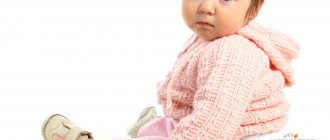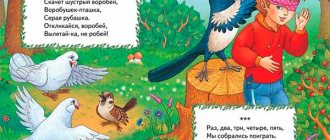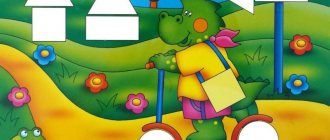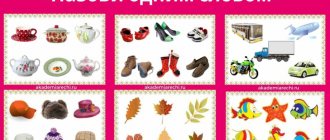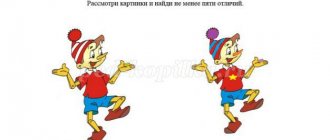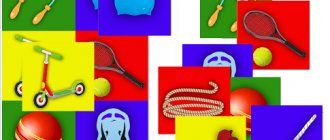Card index on the topic “Outdoor games in summer” card index (senior group)
Card index on the topic “Outdoor games in summer”
Outdoor games during a walk in the warm season
GAMES TO DEVELOP ATTENTION, SPEED, AGILITY AND COORDINATION
"Calling numbers"
Goals:
cultivate attention; develop speed and dexterity of movements, a sense of camaraderie.
Equipment: A flag or medicine ball to indicate where to turn.
Rules. Number of players - 10-20 children. And two teams play, which line up in a column, one at a time, at the starting line. The turning point is marked 15 m away from each team. The captains distribute the players by numbers. The teacher calls out the numbers. Players, having heard their number, run to the turning point, run around it and return to their place. The first to arrive gets a point, the second gets two points. The winning team is determined at the end of the game by the number of points scored.
"Blind Man's Bluff"
Goals:
cultivate attention; develop speed and dexterity of movements.
Equipment: scarf.
Rules. The teacher appoints a leader - blind man's buff. He stands in the middle of the platform, is blindfolded and asked to turn around several times. Then all the children run away on command, and the blind man's buff tries to catch someone. When they see any danger, the players must warn the blind man’s buff with the word “fire.” If the game takes place outdoors, choose a flat area and outline boundaries beyond which the players have no right to go. Having caught someone, the blind man's buff transfers his role to the caught one. A player who crosses the agreed line is considered burned out and must replace his blind man's buff.
"Trap"
Goals: the same.
Rules. The players form two circles. The inner circle, holding hands, moves in one direction, the outer circle in the other. At the teacher’s signal, both cools stop. Those standing in the inner circle raise their hands to form a gate. The rest either run into the circle, passing under the gate, or run out of it. Suddenly the second command is given, the hands are released, and the players inside the circle are considered to be trapped. They remain in the inner circle and join hands with the rest of the players, after which the game is repeated. When there are few players left in the outer circle, an inner circle is formed from them. The game repeats itself.
"Circular lapta"
Goals:
develop agility and speed; be able to navigate in space. Equipment: ball.
Rules. All players are randomly located on a lawn or clearing, in the center is the driver with the ball in his hand. At the signal, the game begins: the driver must hit the ball on any player, who then becomes the driver himself. The game con lasts 6-8 minutes, after which children need to be given a short break.
"Snake"
Goals:
develop coordination of collective actions; be able to navigate in space.
Rules. Number of players: 6-7 children. One of them is a driver. The participants of the game, holding each other, line up in a column - a “snake”. The driver stands in front of the “snake” and tries to stain the last player. The one standing first in the “snake”—the captain—blocks the driver’s path: he spreads his arms wide, sets barriers, and performs various body movements. The “snake” follows the captain and helps block the driver’s path. If the driver stains the player at the end of the column, he becomes the captain, and the stained player becomes the driver. The game can be repeated several times with short breaks for rest.
"Mirror"
Goals:
develop attention and imagination; train in memorizing the sequence of movements.
Rules. The players sit freely on the court and perform the following tasks:
- repeat single movements after the driver;
- reproduce a series of movements in a certain sequence after the driver;
- imitate the movements of an animal, bird, insect, called a driver.
The best player is determined by a general vote and is awarded a prize or bonus points.
"Traps on one leg"
Goals: the same.
Rules. The game is played in the same way as the “Trap” game, but only a new rule is introduced - you cannot catch someone who did not manage to stand on one leg in time and clasp his knee with his hands.
"Birds"
Goals:
develop speed of reaction, arbitrariness of movements, coordination of collective actions; be able to navigate in space.
Rules. The participants of the game are 7-8 children. Children choose “mistress” and “hawk” according to a counting rhyme, the rest are birds. The hostess, secretly from the hawk, gives a name to each bird: “You are a cuckoo, you are a swallow.” A hawk flies.
Mistress. Why did you come? I'm with r e b. For the bird. X o z i k a. For which?
A hawk calls, for example, a cuckoo. If the bird named hawk is not there, the owner drives it away. The game continues until the hawk catches all the birds.
"The cat is coming"
Goals:
develop agility, speed, coordination and speed of movements; cultivate endurance, coordination of collective actions; learn to navigate in space.
Right-handed. A cat is chosen from among the players. He is in the corner of the hall in his house. The rest of the players are mice; they are placed around the hall in holes.
The presenter goes to the middle of the site and says:
Mice, mice, come out, Play, dance, come out quickly, The tired cat-villain is sleeping. The mice run out to the middle of the area and begin to dance, saying:
Tra-ta-ta, tra-ta-ta, we are not afraid of the cat.
At the presenter’s signal “The cat is coming!” all the mice freeze. If any of them moves, the cat takes it into his house. He catches mice until the driver says: “The cat has left.” Caught mice do not take part in the game until a new cat is replaced.
"Little Red Riding Hood"
Goals:
develop attention, intelligence, creative imagination; coordinate collective action; learn to navigate in space.
Equipment: half mask of a wolf, red cap or red riding hood.
Rules. The leader, the wolf, has a cardboard half mask, and the one running away has a red cap. Whoever puts it on becomes Little Red Riding Hood. This player must be caught by the wolf. But the red cap can be transferred to another player. Then the wolf should already be catching up with the new Little Red Riding Hood. When the wolf catches her, he gives her his mask and becomes a player.
"Cosmonauts"
Goals:
develop quick reaction and attention; develop endurance; coordination of collective actions; learn to navigate in space.
Equipment: hoops.
Rules. Children join hands, walk in a circle and repeat in chorus:
Fast rockets are waiting for us for walking around the planets we want - we’ll fly to that one! But there is one secret in the game: There is no room for latecomers!
With the last words, everyone runs away and tries to take their seats (hoop, circle). Only two children can board one rocket. Those who are late gather in the center of the circle, and those who take their places announce their routes (for example, Earth - Moon - Earth, Earth - Mars - Earth, etc.). These names can be written in advance on board the rockets in abbreviated form: Z.L.Z., Z.M.Z. etc. Then everyone gathers in a common circle, joins hands, and the game is repeated. The winners are those who managed to make more flights during repetition. It is prohibited to rush towards the missiles prematurely and push comrades from their occupied places in the missiles.
"Cat and Mouse"
Goals:
develop coordination of collective actions; learn to navigate in space.
Rules. Having chosen a cat and a mouse, the rest of the players stand in a circle and join hands. The cat is outside the circle, the mouse is inside it.
The cat every now and then tries to break through to the mouse, which is protected by the other players: they prevent the cat from slipping through underneath, lowering their hands; they try to prevent her from jumping over their closed hands, raising them.
But when the cat manages to break into the circle, the players should quickly open the chain so that the mouse can jump out of the circle and have time to join hands before the cat runs out after the mouse. While outside, the mouse teases the cat, and when the latter manages to jump out of the circle, players must temporarily open the circuit again to let the mouse in, but not the cat. The game continues until the cat catches the mouse.
"Tug of War"
Goals:
develop coordination of collective actions; develop endurance.
Equipment: rope or rope.
Rules. Children are divided into two teams, each team takes its end of the rope and pulls as hard as possible. Whoever wins wins. To conveniently determine the winner, a line is drawn between teams that cannot be crossed.
"The Birds and the Cage"
Goals: the same.
Rules. Children are divided into two teams. One forms a circle in the center of the playground (children walk in a circle holding hands) - this is a cage. The other team is the birds. The presenter says: “Open the cage!” Children forming a cage raise their hands. The birds fly into the cage (in a circle) and immediately fly out of it. The presenter says: “Close the cage!” The children give up. Birds remaining in the cage are considered caught. They stand in a circle. The square increases and the game continues until 1-3 birds remain. Then the children change roles.
"Traps in pairs"
Goals:
develop coordination of collective actions; learn to navigate in space.
Rules. They choose a driver. At his signal, the children scatter. The driver catches by touching the runner with his hand. The caught one becomes a pair with him. They join hands and catch other children. Those caught also form a pair and participate in fishing. The game ends when all the children are caught. The last child caught becomes the driver.
"Trap-Dashes"
Goals: the same.
Rules. A group of children stands on one side of the playground beyond the line. A line was also drawn on the opposite side of the site. In the middle, between the two lines, there is a trap. After the words: “One, two, three - catch it!” the children run to the other side of the playground, and the trap catches them. The one whom the trap manages to touch before the runner crosses the line is considered caught and moves aside. After 2-3 runs, the number of those caught is counted and a new trap is selected.
"Cockfight"
Goals: the same.
Rules. The players try to throw each other off balance by jumping on one leg and pushing each other with either their right or left shoulder. The one who touches the ground with his second foot loses.
Children hold their hands on their belts or crossed in front of their chests; You can hold on to the toe of your bent leg with one hand. Pushing with hands is not allowed. The winner is the one who can hold on longer while jumping on one leg.
“Build a line, a circle, a column”
Goals: the same.
Equipment: tambourine and flags.
Rules. Children are divided into two groups and lined up on opposite sides of the playground or room in two lines, facing each other. Then, at the leader’s signal, they walk or run (depending on the pace and rhythm that the leader sets by striking the tambourine) throughout the entire area (room). Having stopped hitting the tambourine, the leader says: “Build a line (circle, column)!”, and the children line up in their places in a line (circle, column). The group that builds faster and more correctly (straighter) wins.
Game options:
- after the signal, you must line up not in any order, but exactly in your place in the line, column or circle;
- each group is lined up next to a flag of its own color (in a line - the flag to the right of the first - the right-flank; in a circle - the flag in the center; in a column - the first stands facing the flag).
While running, before giving the signal to form, the leader says: “Stop!”, The children stop and close their eyes. The presenter at this time moves the flags to other places and then says how they should line up. Children open their eyes, find their flag and run to line up towards it.
"Two and Three"
Goals: the same.
Rules. Children walk or run in all directions. At the presenter’s signal “Two!” They form pairs with any child nearby, hold hands and run to a pre-agreed place (flag, tree), where they line up pair by pair in the order in which they run up. If the leader says: “Three!”, the children form threes and then run to the formation site.
Game option. Children must line up in front of the leader (facing him), no matter where he is on the site or room. To make the game more difficult and interesting, the presenter, before giving the signal to form, says: “Stop!” The children stop and close their eyes. The presenter moves to another place and gives the signal “Two!” or “Three!”, children open their eyes, form pairs or triplets and run to line up.
"Ship Voyage"
Goals: the same.
Rules. Children line up in two lines at one side of the playground (room) - this is a ship. The ship's captain (leader) announces: “Prepare to go ashore, land to the right!” All children should turn to the right in preparation to leave. Anyone who turns in the other direction is deprived of access to the shore and remains on the ship (steps aside). Everyone else goes in pairs (possibly with a song or while beating a tambourine) and, having walked around the area (room), return to the ship (to the place of initial formation) and form up again | two ranks. The children who remained on the ship join the game, taking their places in the ranks. To the words of the presenter: “Get ready to leave, there’s land on the left!” the children turn to the left and, going around the area (room), return to the ship and line up in two lines. The names of the sides (right, left) must not only be alternated, but also given separately.
"River and Ditch"
Goals: the same.
Rules. Children line up in a column in the middle of the playground, one at a time. To the right of the column is a moat, to the left is a river. You need to swim across the river (walk, imitating the movements of a swimmer with your hands), and jump over the ditch. At the teacher’s signal, “The ditch is on the right!” children turn to the right and jump forward. The one who jumped in the other direction is considered to have fallen into the river; they help him get out by giving him a hand. Then everyone returns to the initial formation. At the signal “River on the left!” children turn left and “swim to the other side.” The one who made a mistake and ended up in a ditch is given a hand, and he returns to his comrades.
"Traffic light"
Goals: the same.
Equipment: red, green and yellow mugs with a diameter of 10 cm.
Rules. Mugs (diameter 10 cm) are made in red, green and yellow, which are attached to sticks. Children stand in a line and perform exercises according to the leader’s signals: when the signal is red they crouch, when the signal is yellow they stand up, when the signal is green they march in place.
While moving in a column one by one around the site, the exercises change: red - everyone stands still, yellow - they move forward in a squat, green - they jump on their toes.
For each mistake, players are awarded penalty points. The one who scores fewer penalty points wins.
"Third wheel"
Goals: the same.
Rules. The players are distributed in pairs and, holding hands, walk in a circle. The distance between pairs is at least four steps. Two players designated as the leader run in any direction (crossing the circle is allowed). One of them, running away, can attach itself to any pair. To do this, he must run up to her from the right or left and take the last one by the hand. The player who turns out to be the third wheel (on the other side) runs away from the leader. The rules provide for a change of leader if he insults the runner.
"The Fisherman and the Fishes"
Goals: the same.
Rules. A large circle is drawn on the floor or platform. One of the players - the fisherman - is in the center of the circle, he squats down. The rest, the fish, surrounded the circle and said in unison: “Fisherman, fisherman, catch us on a hook.”
At the last word, the fisherman jumps up, runs out of the circle and begins to chase the fish, which scatter all over the area. The one who is caught becomes a fisherman and goes to
Goals:
develop reaction speed; develop imitation abilities.
Rules. Number of players: 8-12 children. A dog is chosen from among the players. He sits on the side. Other children slowly walk towards him, saying:
Here is a shaggy dog sitting with his nose buried in his paws. Quietly, peacefully he sits, maybe dozing, maybe sleeping. Let's go up to him, wake him up and see what happens?
Children quietly approach the dog and clap their hands. The dog jumps up, growls, barks and catches the children. The caught player becomes the driver - the dog.
Games and fun in inclement weather under a canopy
or on the veranda.
Weather conditions do not always allow playing with children outdoors. In case of inclement weather in spring, summer and autumn, you can organize exercises and fun, read poetry, and solve riddles on the veranda or under a canopy.
I offer games and entertainment designed to be held in a small area of a canopy or veranda, so all children in the group cannot participate in them at the same time. Children perform a variety of motor tasks in groups, taking turns, and exciting competitions between groups can be organized. The recommended activities are simple, almost all of them are accessible to children of primary preschool age, but are also attractive to older preschoolers.
IN A SMALL FREE PLACE.
1. Sit down - stand up.
Crossing your legs, clasping your shoulders with your hands, you need to raise your arms bent at the elbows in front of you, sit down and stand up without helping yourself with your hands.
2. Let's sit as a couple.
Children stand with their backs to each other and clasp their arms bent at the elbows. At the same time they sit down and stretch their legs. Then they try, bending their legs and leaning against each other’s backs, to stand up. Let's see which couple will succeed.
3. Who can do it?
In a standing position, you need to raise your right and left shoulders in turn, trying to reach your ear with your shoulder.
Options: After crouching and placing your hands on the floor, you need to jump and put your feet apart, while your hands remain on the floor. Then you should straighten up, rest and do the exercise again.
4. Hold on!
Two guys stand one opposite the other at a distance of half a step, toes and heels together, arms bent in front of the chest, palms forward. In this position, light pushes of the palms should force the partner to lose balance. The one who moves from his place, leaves it with at least one foot, loses.
5. Cockfight.
The players try to throw each other off balance by jumping on one leg and pushing each other with either their right or left shoulder. The one who touches the ground with his second foot loses. Children hold their hands on their belts or crossed in front of their chests; You can hold on to the toe of your bent leg with one hand. Pushing with hands is not allowed. The winner is the one who can hold on longer while jumping on one leg.
6. Get through your hands.
Having clasped the fingers of both hands, you should try to crawl through your hands so that they are behind you. At the same time, you must keep your hands “locked” without letting go.
7. Don't hurt your forehead.
It is suggested to stand up straight, then calmly bend down and, without bending your knees, touch them with your forehead. If the task fails, the child helps himself with his hands, pulling himself up, holding his hips. Then it is proposed to bend not smoothly, but more sharply, trying to touch the knees with the forehead in a sweeping manner. But you have to be careful not to hurt your forehead.
8. Reach out.
A small town (cube) is placed at a distance of about a step from the line. Without bending your knees, you need to reach out to the town and take it. You can't cross the line!
9. Try and pick it up.
The child stands in front of the skittle, holding the pin so that the object remains behind his back at a distance of a foot’s length. Having crouched, he must reach out to the town, grab it with both hands and, without stepping on his feet, maintaining his balance, try to stand up. The winner is the one who manages to complete the task in one attempt.
10. Put it in place.
Holding the town behind his back with both hands, the child from a standing position, legs together, must squat down, place the town on the ground and stand up, maintaining balance.
11. Stop, stop, stick, don’t fall!
It is proposed to place a stick 70-80 cm long with evenly cut ends on the floor, holding it with both hands, and give it a position so that it does not fall when it is released. If the released stick begins to fall, you must quickly catch it without letting it touch the floor.
Options: Having given the stick a balanced position, you need to quickly release it, clap your hands and catch it again. Then try to clap your hands 2-3 times in a row before the stick starts to fall.
12. Walk under the stick.
It is proposed to rest the stick on the floor in front of you with one hand and, without letting go of the stick, walk under this hand, turning forward with the opposite shoulder.
13. Step over the stick.
The child takes the stick with both hands by the ends, steps over it first with one foot, then with the other, so that the stick is behind him. Then he steps back over the stick so that it is in front again.
Options: Sitting with legs extended, the child holds a stick. He is asked to bend, lift and move both legs over the stick at the same time, first forward, then back.
14. Get out of the hoop.
The child squats in the center of the hoop, resting his hands on the floor in front. Stepping backwards with your feet, you go beyond the hoop without changing your position. Then he also enters the hoop and straightens up.
15. Step into a hoop.
Each player takes a hoop and holds it with both hands below. It is proposed to step one by one with both feet into the hoop, and then lift it along the entire body high above your head. You can also do the opposite movement: lower the hoop onto your shoulders and lower so that it is convenient to step back from it.
16. Get through the hoop.
Lying on their backs, children hold the hoop up. Then you need to get up, sit down, lean forward, lift your legs off the floor and put them through the hoop; lie on your back, rest your feet on the floor, bending them slightly, lift your torso and remove the hoop over your head. Then it is proposed to do the same movements, starting from the head. Who will do it faster? (This exercise is best done on a mat.)
17. Walk around the hoop.
The child is lying down and leans from behind in the center of the hoop, with the torso raised. Then he steps his feet around the hoop outside (or inside).
18. Jump out of a hoop.
The position is the same as in the previous exercise. Without taking your hands off the floor, push off with your feet and jump back behind the hoop, then jump into it.
19. Spin in a hoop.
It is suggested to sit in the center of the hoop on the mat, then, slightly raising your legs, push off vigorously and, waving your arms, try to turn in a circle. Who will turn next?
Variations: Standing on one leg in the middle of the hoop, the other child leans on the ball lying at the very rim of the hoop. Spinning around himself, he dribbles the ball along the hoop.
20. Hit the pin.
The child is asked to sit down and lean his hands behind him, bend his legs. A ball is placed in front of your feet. He must push the ball, straightening his legs, so as to hit the pin placed at a distance of 3-4 steps.
21. Miss the ball.
The child sits down with his hands behind him and his legs slightly pulled up. An adult or one of the comrades with a small ball in their hands stands a few steps away. Saying: “Hop!”, he rolls the ball towards the seated person. He quickly rises up, leaning on his arms and legs, trying to bend so that the ball rolls under him without hitting him.
22. Rope behind the back.
The child takes both ends of a thick rope (50-60 cm long) with his hands and, without bending his arms, moves it over his head and behind his back. If the task is easy, then you can reduce the distance between your hands when grabbing the rope.
23. Who is faster?
Children stand with their backs to each other at a distance of a step, placing their feet apart, then place a rope or tape between their legs. On the count of “One, two, three!” you need to quickly lean forward, trying to quickly pull the rope in your direction. Whoever manages to do this will win.
24. Middle!
Sticks are attached to a ribbon 2-3 m long at both ends, and the middle is marked with colored tape. Two children move away from each other, stretching the ribbon, and stand facing each other, holding the ends of the sticks with both hands. Quickly moving their fingers, they wrap the ribbon around the sticks, trying to reach the middle of the ribbon as quickly as possible. Whoever manages to do this first says: “Middle!” - and wins.
25. Guess who did it?
One child is designated as the driver. Holding one hand behind his back, palm up, he stands with his back to the other players, who are positioned around him in a semicircle. By agreement, one of the players quietly approaches the driver, touches his hand and quickly returns to his place. As soon as the driver feels someone's touch, he begins to count out loud to three, then turns to face the players and tries to guess (by facial expression, movement, body position and other objects) who approached him. If the driver guesses correctly, he changes with the player who approached him, but if not, then the game continues in the previous arrangement of players.
